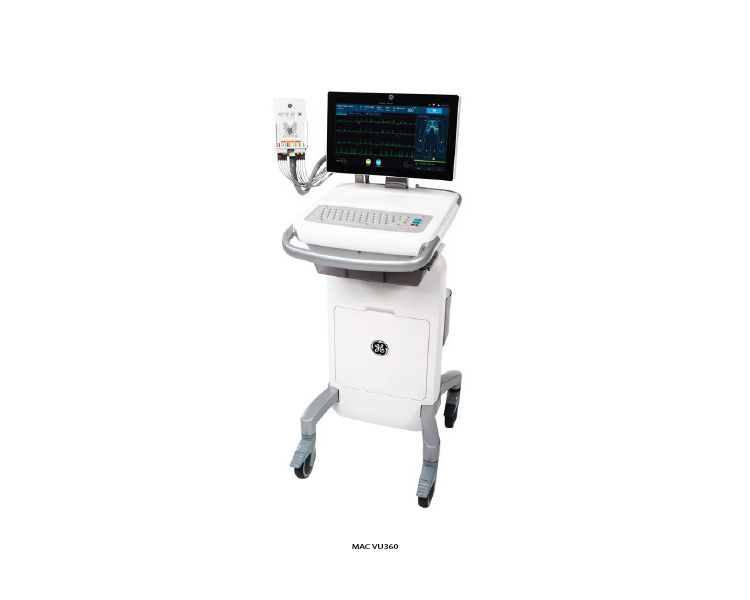MAC 7
The MAC 7 Resting ECG system is engineered to deliver high-quality ECG recordings with ease of use and flexibility. It offers essential diagnostic capabilities for healthcare providers while prioritizing patient comfort and safety. Whether in hospitals, clinics, or physician offices, the MAC 7 serves as a dependable tool for routine cardiac assessments and diagnostic evaluations.
Key Features of MAC 7
1. Compact and Portable Design:
• The MAC 7 is designed to be lightweight and portable, making it suitable for use in various clinical environments, including bedside and outpatient settings.
• Its compact footprint saves space and enhances mobility within healthcare facilities.
2. User-Friendly Interface:
• Features an intuitive user interface with a touchscreen display for easy navigation and operation.
• Simplified workflow with guided prompts and step-by-step instructions ensures efficient ECG acquisition.
3. High-Quality ECG Acquisition:
• Provides clear and artifact-free ECG tracings, thanks to advanced signal processing technology.
• Offers simultaneous 12-lead ECG recording for comprehensive cardiac assessment.
4. Integrated Interpretation Software:
• Includes built-in ECG interpretation algorithms that aid in rapid analysis of cardiac rhythms and morphologies.
• Supports automated interpretation and analysis, helping clinicians identify abnormal findings more efficiently.
5. Customizable Recording Options:
• Allows for flexible recording configurations, including lead selection, paper speed, and print format customization.
• Supports user-defined presets for quick and easy setup according to specific clinical requirements.
6. Data Management and Connectivity:
• Enables seamless connectivity with hospital information systems (HIS) and electronic health records (EHR) for streamlined data management.
• Supports wired or wireless data transfer, facilitating efficient transmission of ECG reports and patient information.
7. Patient Comfort and Safety:
• Features ergonomic design elements and patient-friendly electrodes to enhance comfort during ECG acquisition.
• Adheres to safety standards and protocols to minimize the risk of patient discomfort or injury.
Clinical Applications of MAC 7
1. Routine Diagnostic Testing:• Facilitates routine ECG screening and diagnostic testing for various cardiac conditions, including arrhythmias, conduction abnormalities, and ischemic heart disease.
• Provides essential data for assessing cardiac function and guiding clinical decision-making. 2. Preventive Cardiology:
• Supports early detection of cardiovascular risk factors and abnormalities in asymptomatic patients during routine health screenings.
• Helps identify individuals at risk for heart disease and initiates appropriate interventions to prevent adverse outcomes.
3. Emergency Department (ED) Triage:
• Enables rapid acquisition and interpretation of ECG tracings in emergency settings to assist in the diagnosis and management of acute cardiac events.
• Supports timely triage decisions and facilitates prompt initiation of treatment for patients presenting with chest pain or other cardiac symptoms.
4. Preoperative Assessment:
• Aids in preoperative risk stratification by evaluating cardiac function and identifying patients at increased perioperative risk.
• Helps optimize perioperative management strategies to enhance patient safety and outcomes.
MAC VU360
The MAC VU360 Resting ECG system is designed to streamline the process of acquiring, interpreting, and storing ECG data. It is equipped with intuitive features that enhance workflow efficiency while ensuring high-quality recordings. The system caters to the needs of healthcare professionals in various settings, including hospitals, clinics, and physician offices.
Key Features of X-Line Body Contour Tape
1. Advanced Signal Processing:
• Incorporates advanced algorithms for signal processing, ensuring clear and artifact-free ECG recordings.
• Offers high-fidelity waveform acquisition, allowing for accurate interpretation of cardiac activity.
2. Intuitive User Interface:
• Features a user-friendly interface with touchscreen functionality for easy navigation and operation.
• Simplifies ECG acquisition with guided prompts and intuitive workflow steps.
3. Customizable Recording Options:
• Provides flexibility in selecting recording formats, lead configurations, and paper speeds to meet specific clinical requirements.
• Supports multiple recording modes, including standard 12-lead ECG, rhythm strip, and configurable lead groups.
4. Integrated Interpretation Software:
• Includes built-in ECG interpretation algorithms for rapid analysis of cardiac rhythms and morphologies.
• Facilitates accurate diagnosis by providing immediate feedback on ECG findings.
5. Data Management and Connectivity:
• Offers seamless connectivity with hospital information systems (HIS) and electronic health records (EHR) for efficient data transfer and storage.
• Allows for easy retrieval and review of previous ECG recordings, enhancing continuity of care.
6. Quality Assurance Features:
• Incorporates quality assurance tools to verify electrode placement, signal integrity, and recording completeness.
• Alerts users to potential issues during ECG acquisition, ensuring data accuracy and reliability.
7. Patient Comfort and Safety:
• Features ergonomic design elements and patient-friendly electrodes to maximize comfort during ECG acquisition.
• Adheres to safety standards and protocols to minimize the risk of patient harm during the procedure.
Clinical Applications of MAC VU360
1. Diagnostic ECG Testing:• Facilitates the diagnosis of various cardiac conditions, including arrhythmias, conduction abnormalities, and ischemic heart disease.
• Provides essential data for assessing cardiac function and identifying potential risk factors.
2. Routine Screening and Monitoring:
• Supports routine ECG screening in primary care settings to detect underlying cardiac abnormalities and monitor changes over time.
• Enables longitudinal tracking of cardiac health in patients with chronic conditions or risk factors.
3. Preoperative Assessment:
• Assists in preoperative risk stratification by evaluating cardiac function and identifying patients at increased perioperative risk.
• Helps optimize perioperative management strategies to enhance patient safety and outcomes.
4. Emergency Department (ED) Triage:
• Facilitates rapid ECG acquisition and interpretation in emergency settings to guide triage decisions and facilitate timely treatment.
• Supports early identification of acute cardiac events, such as myocardial infarction or arrhythmias, for prompt intervention.
5. Exercise Testing Support:
• Integrates with exercise stress testing systems to provide baseline and exercise-induced ECG recordings for comprehensive assessment of cardiac function.
• Enhances diagnostic accuracy by capturing dynamic changes in cardiac activity during stress testing protocols.


